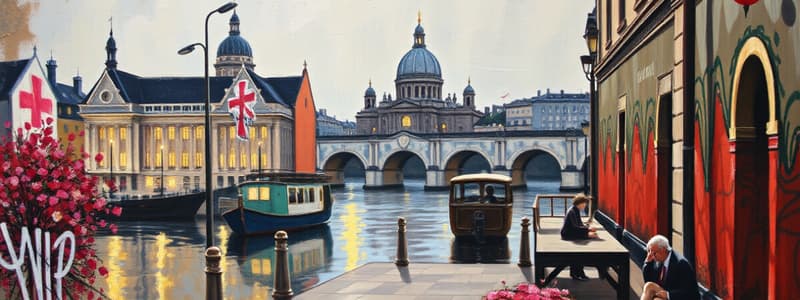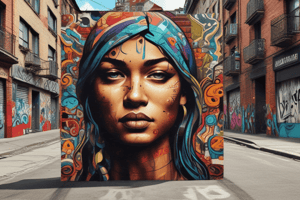Podcast
Questions and Answers
What was the nickname of the first 'tagger' mentioned?
What was the nickname of the first 'tagger' mentioned?
- TAKI (correct)
- Barbara
- Demetrius
- Joe
In which decade did aerosol paint graffiti become widely popular?
In which decade did aerosol paint graffiti become widely popular?
- 1980s
- 1990s
- 1960s
- 1970s (correct)
What did Demetrius do at subway stations?
What did Demetrius do at subway stations?
- He painted large murals.
- He organized graffiti events.
- He created social awareness art.
- He wrote his tag on the wall. (correct)
How did street artists in South America contribute to urban areas?
How did street artists in South America contribute to urban areas?
What is a common perception of graffiti in many countries?
What is a common perception of graffiti in many countries?
What can be found in graffiti zones in places like Taiwan?
What can be found in graffiti zones in places like Taiwan?
What did some graffiti artists in the 1990s and 2000s focus on beyond tagging?
What did some graffiti artists in the 1990s and 2000s focus on beyond tagging?
Which city hosts an annual street art festival in August?
Which city hosts an annual street art festival in August?
Where did graffiti appear prominently in the late 70s and 80s?
Where did graffiti appear prominently in the late 70s and 80s?
What was one of the earliest forms of graffiti found by archaeologists?
What was one of the earliest forms of graffiti found by archaeologists?
What significant change occurred in graffiti style in the late 1970s?
What significant change occurred in graffiti style in the late 1970s?
Which of the following exemplifies the dual perception of graffiti in society?
Which of the following exemplifies the dual perception of graffiti in society?
What tactic did Demetrius use to avoid getting caught while tagging?
What tactic did Demetrius use to avoid getting caught while tagging?
Which aspect of graffiti gained popularity in the 1990s and 2000s?
Which aspect of graffiti gained popularity in the 1990s and 2000s?
What characterizes the street art festivals commonly held today?
What characterizes the street art festivals commonly held today?
In which city are artists allowed to paint freely on subway trains?
In which city are artists allowed to paint freely on subway trains?
What consequence do street artists face in many countries for painting on walls?
What consequence do street artists face in many countries for painting on walls?
Which feature distinguishes modern graffiti in urban settings today?
Which feature distinguishes modern graffiti in urban settings today?
What was the original purpose of tags written by teenagers in New York?
What was the original purpose of tags written by teenagers in New York?
Flashcards are hidden until you start studying
Study Notes
Historical Background of Graffiti
- Prehistoric humans in Africa and Europe painted animals and human figures in caves.
- Ancient graffiti discovered in Greece, Italy, Syria, and Iraq.
- Pompeii revealed extensive graffiti in Latin, including political messages and magic spells.
Emergence of Modern Graffiti
- 1970s New York saw youth writing 'tags' using pens on city walls.
- Demetrius, a notable tagger, created the tag TAKI 183, combining his nickname and street number.
- Initially tagged in his neighborhood, he expanded to subway stations, influencing other teenagers.
Evolution to Aerosol Paint
- Transition from pens to aerosol paint led to larger, colorful tags.
- Graffiti gained popularity across trains, buses, and urban walls in the 1970s and 1980s.
Artistic Development
- By the 1990s and 2000s, graffiti artists began creating elaborate pictures.
- Some artists highlighted political issues and social discrimination, while others focused on beautifying urban settings.
- In South America, street artists revitalized poorer areas with vibrant artwork.
Graffiti: Art or Vandalism?
- Graffiti considered a crime in many regions, leading to potential legal issues for street artists.
- In select countries, like Taiwan, designated 'graffiti zones' allow freedom for artists.
- São Paulo's city council permits certain artists to paint subway trains legally.
Contemporary Street Art Culture
- Street art has gained popularity, with festivals celebrating the medium, such as Bristol's annual street art festival in August.
- Galleries in cities like Paris, London, and Los Angeles have hosted exhibitions showcasing street art.
Historical Context of Wall Art
- Prehistoric humans in Africa and Europe created cave paintings of animals and people.
- Ancient graffiti discovered in Greece, Italy, Syria, and Iraq highlights a long tradition of wall writing.
- Pompeii, a Roman town, revealed Latin graffiti with themes ranging from politics to magic spells.
Birth of Modern Graffiti
- In the 1970s New York, young people began to use pens for tagging walls with their names.
- Demetrius, known as TAKI 183, was one of the first taggers; his name combined his nickname with his street number.
- TAKI 183 emerged as a local phenomenon, with Demetrius tagging walls and subway stations during his commutes.
Rise of Aerosol Graffiti
- Following Demetrius, more teenagers began tagging their names around the city, leading to the emergence of tags like Barbara 62 and Joe 182.
- The shift from pens to aerosol paints allowed for larger, more vibrant graffiti pieces, becoming popular in the late 1970s and 1980s.
- This trend expanded beyond New York, affecting urban landscapes globally.
Evolution of Graffiti Art
- In the 1990s and 2000s, graffiti artists began to create large-scale pictures addressing social and political issues.
- Street art in South America focused on beautifying impoverished neighborhoods, transforming dull urban walls with vibrant art.
Current Perspectives on Graffiti
- The classification of graffiti remains contentious, with debates around its status as art vs. vandalism.
- In many regions, unauthorized graffiti is illegal, leading to potential legal issues for street artists.
- Certain areas, such as 'graffiti zones' in Taiwan and approved projects in São Paulo, Brazil, allow for legal street art.
Popularity and Recognition of Street Art
- Street art has gained public acceptance and is celebrated through festivals, notably in Bristol, UK, which hosts an annual street art event.
- Art galleries in cities like Paris, London, and Los Angeles feature exhibitions dedicated to street art, bridging the gap between urban expressions and formal art spaces.
Studying That Suits You
Use AI to generate personalized quizzes and flashcards to suit your learning preferences.




